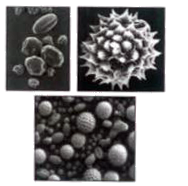Describe the structure of pollen grain and explain the development of male gametophyte in itSolution in Gujrati
The pollen grains represent the male gametophytes that is located in microspores. By touching the opened anthers of Hibiscus or any other flower, deposition of yellowish powdery pollen grains are found on fingers. Sprinkling these grains on a drop of water taken on a glass slide and observing under a microscopes, variety of architecture sizes, shapes, colours, designs are seen on the pollen grains from different species.
Structure of Pollen grains: Pollen grains are generally spherical measuring about 25-50 micrometers in diameter. It has a promient two layered wall. The hard outer layer called the exine is made up of sporopollenim which is one of the most resistant organic material

It can withstand high temperatures and strong acids and alkali. No enzyme that degrades sporopollenin is so far known.

Pollen grain exine has prominent apertures called germ proes. Where sporopollenn is absent. Pollen grains are well preserved as fossils because of the presence of sporopollenin. The inner wall of the pollen grain is called the intine. It is a thin and continuous layer made up of cellulose and pectin.
The development of male gametophyte in pollen grain. The cytoplasm of pollen grain is surrounded by a plasma membrane. When the pollen grain is mature it contains two cells, the vegetative cell and generative cell. The vegetative cell is bigger, has abundant food reserve and a large irregularly shaped nucleus. The generative cell is small and floats in the cytoplasm of the vegetative cell. It is spindle shaped with dense cytoplasm and a nucleus. In over 60 percent of angiosperms, pollen grains are shed at this 2-celled stage. In the remaining species, the generative cell divides mitotically to give rise to the two male gametes before pollen grains are shed (3-celled). Pollen grains of many species cause severe allergies and bronchial affictions in some people often leading to chronic respiratory disorders-asthma bronchitis etc.
Note: It may be mentioned that Parthenium of carrot grass that came into India as contaminant with imported wheat, has become ubiquitous in occurrence and causes pollen allergy.
Topper's Solved these Questions
- BOOK - KUMAR PRAKASHANCHAPTER - SEXUAL REPRODUCTION IN FLOWERING PLANTSEXERCISE - Section -A (Double Fertilization)1videos
SEXUAL REPRODUCTION IN FLOWERING PLANTS
- BOOK - KUMAR PRAKASHANCHAPTER - SEXUAL REPRODUCTION IN FLOWERING PLANTSEXERCISE - Section -A (Post Fertillisation: Structures And Events)5videos
SEXUAL REPRODUCTION IN FLOWERING PLANTS
- BOOK - KUMAR PRAKASHANCHAPTER - SEXUAL REPRODUCTION IN FLOWERING PLANTSEXERCISE - Section -A (Flower-A Fascinating Organ of Angiosperms)3videos
SEXUAL REPRODUCTION IN FLOWERING PLANTS
- BOOK - KUMAR PRAKASHANCHAPTER - REPRODUCTIVE HEALTH EXERCISE - Section - F Multiple Choice Questions (MCQs)102videos
REPRODUCTIVE HEALTH
- BOOK - KUMAR PRAKASHANCHAPTER - STRATEGIES FOR ENHANCEMENT IN FOOD PRODUCTIONEXERCISE - SECTION -F (Multiple Choice Questions (MCQs)) (MCQs Asked In Competition Exam)63videos
STRATEGIES FOR ENHANCEMENT IN FOOD PRODUCTION
Similar Questions
Explain double fertilisation angiosperms
04:28View SolutionWhat is endosperm? Describe types of endosperm
04:25View SolutionMention social, religious and cultural value of the flowers
03:08View SolutionWhich problems arise due to uncontrolled population growth ?
02:15View SolutionPollen-grains of a plant whose 2n = 28 are cultured to get callus by tissue culture method. What would be the number of chromosomes in the cells of the callus?
View SolutionMale gametophyte (mature pollen grain) of Pinus is found to be
09:53View SolutionAssertion. A pollen grain of angiosperm is considered as the male gametophyte . Reason. All the nuclei of the pollen grain produce male gametes.
04:39View Solutionपरागकण की संरचना का वण्रन कीजिए।
03:49View SolutionAssertion (A) : Microspores are the first cell of male gametophyte.
Reason (R) : Microspores undergo development and forms pollen grains.03:49View SolutionDescribe the structure of a pollen grain.
31:29View SolutionExplain the structure of pollen grain.
04:34View SolutionThe pollen grain is related to the embryo sac as
(A) male gametophyte is to the egg
(B) male gametophyte is to the female gametophyte
(C) sperm is to the egg
(D) sperm is to the female gametophyte01:11:12View SolutionDescribe the development of male gametophyte in Angiosperms.
32:26View SolutionAssertion. A pollen grain of angiosperm is considered as the male gametophyte . Reason. All the nuclei of the pollen grain produce male gametes.
03:07View SolutionMicrosporogenesis|Male Gametophyte|Microgametogenesis|Characterstics Of Pollen Grain|Questions|OMR
View Solution

